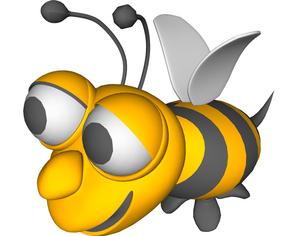Russedl Bee and Hornet Removal Hives Removal

Bee and Hornet Removal
Frequently Asked Questions.
Below are questions that our customers ask us all the time. Can't find the answer to your questions? Drop us an email and we'll bee right back to you!

The first thing to do in the event of a bee sting or multiple stings is get the stinger out. When the honey bee stings a human with their barbed stinger, they don't have the strength to pull their stinger out of the skin and end up ripping away from the stinger leaving it and the venom sac behind, which will continue to release venom for several minutes afterward. This is why the honeybee can only sting once. It is also why if you get a bee sting the stinger should be scraped out and not pulled out so the remaining venom in the sac isn't released. You can use a key, credit card, fingernail or whatever you have to scrape the stinger out. Local swelling and redness is a normal reaction and often confused for an allergic reaction. Ice can help reduce the swelling which can persist for a couple of days. Itching is also common for a couple days after a bee sting. Antihistamine's or anti- itch lotion will reduce itching. A true allergic reaction means the swelling spreads to the tongue and throat making breathing difficult and could be life threatening. If a known allergy exists, you should ask your doctor about an Epi Pen ( RX required) whichshould be carried at all times and administered immediately after a bee sting.
Bee Removal and Hornet Removal
in Sarasota to Marco Island
Bee Removal in Sarasota Bee Removal in Punta Gorda Hornet Removal
941-743-2302 or 888-380-2974

Bee and hornet removal service in Marco Island, FL Naples, FL, Bonita Sprints, FL, Fort Myers, FL, Sanibel, FL, North Fort Myers, Florida, Punta Gorda, FL, Port Charlotte, FL, Englewood, FL, Manasota Key, FL, Placida, FL, North Port, FL, Venice, FL, Sarasota, FL, Bradenton, FL, Arcadia, FL, Winter Park, FL, Sebring, FLType your paragraph here.
What to do if attacked by Swarm
When the hive is signaled to attack, the killer bee like all honey bees will swarm out of the nest and attack anything in the vicinity. Once a bee stings they release a pheromone marking the person as a threat. Unlike European honey bee that will abandon an attack pretty quickly, the African honey bee has been know to chase a perceived threat for up to 1/4 mile. Jumping in water will not help either as the killer bee will hover over a person in water for up to a half an hour. The first thing to do is run in a straight line to the nearest shelter. Get inside a car or structure since it's better to be stuck with a couple dozen that to expose yourself to a couple thousand. If shelter is not available, keep running in a straight line as fast as you can until you are clear of the bees. Immediately deal with any stings you've received and then call a bee removal specialist to remove the threat.
Where to look for African Bee Hives
The African Honey Bee is less discriminating than the European Honey Bee about where to build their nests. If you see bee activity on your property and suspect an infestation, here are the most common spots to look out for killer bees: Eaves, Soffit, In and around chimneys, Roof vents, Gutters, Water meters, Cinder blocks, Bird houses, BBQ Grills,Flower pots, Wood piles, Wheel barrows, and Empty containers and barrels. Africanized honey bees will build a home in most any open space. They can be almost anywhere. The European honey bee looks for a more protected place from the elements and predators.
Why eliminate not Relocate
The State of Florida recommendation established by the Florida Department of Agriculture and Consumer Service's (FDACS) Apiary Section is that all wild colonies or swarms located in close proximity to people or animals should be eradicated by a pest control operator (PCO) trained in honey bee colony eradication and removal. The reason FDACS recommends eradicating swarms or nesting honey bee colonies located in close proximity to people or animals is due to the presence of African honey bees in Florida. African honey bees (AHB) and European honey bees (EHB) (the latter is the kind beekeepers usually keep) bees cannot be distinguished from one another with the unaided eye. The only way to identify African bees is to send a sample of 50 freshly collected bees in alcohol to the Apiary Section of FDACS Jerry Hayes - hayesg@doacs.state.fl.us.
Once received, the samples undergo rigorous morphological computerized testing to determine the bee race. Obviously, it is not safe to tell a customer to collect a sample of bees from a living bee colony. As such, the state recommends that the suspect colony be eradicated to avoid any negative encounter.
Additionally, European and African honey bees are capable of interbreeding, meaning a hive that has been in a tree quietly for years may become Africanized suddenly if, following a swarming of the colony, the new queen in the colony mates with Africanized drones during her mating flight.
Besides general safety, nesting honey bees and swarms become a liability issue for the homeowner. If the suspect bees are Africanized and attack a neighbor's child, pet, etc., the homeowner is liable for the attack because they knew the nest was there and chose not to follow state recommendations.
The state does not recommend that beekeepers collect these hives or swarms as they once did. It only takes about 5 seconds for African bees to become defensive if disturbed, and they will travel much farther from the nest than European bees. The PCOs on FDACS list have been trained to handle nesting honey bee colonies and should know the proper procedures for handling an African bee nest.
Many people are aware that honey bee populations are suffering and see a dichotomy between the "save the bees" and "eradicate the bees" messages. However, this dichotomy is false. Colony Collapse Disorder is a managed bee colony problem and not an African bee one. So eradicating a nesting colony on ones property does little, if anything, to the total number of wild honey bee colonies in Florida. Homeowners often assume that a newly arrived swarm "can't be Africanized because they haven't bothered anyone". The problem is that neither AHB nor EHB swarms are defensive for the first several weeks, but once baby bees are present in the comb, AHB colonies become dangerously defensive. This behavior will often first shows itself in a dangerous attack
